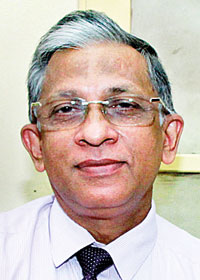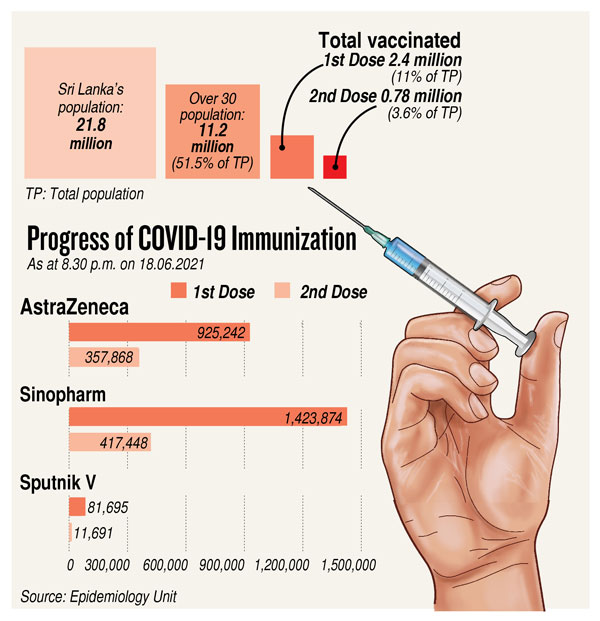News
Close eye on WP as restrictions are eased – DG
“The travel restrictions are being lifted under very strict conditions,” the Director-General (DG) of Health Services, Dr. Asela Gunawardena told the Sunday Times on Friday night, reiterating that inter-provincial crossings are not allowed and they would “observe closely” the results of the easing of restrictions within the next week.

Dr. Asela Gunawardena
The restrictions are being lifted at 4 a.m. tomorrow, re-imposed at 10 p.m. on June 23 and lifted once again at 4 a.m. on June 25.
Explaining that a close eye will be kept on the Western Province, the DG stressed that no gatherings would be allowed across the country even though travel restrictions are being eased.
He said that the mantra for the control of COVID-19 was taking the four important precautions of face-mask wearing, keeping at least a metre distance from others, hand hygiene and scrupulously avoiding crowds including attending parties, etc. This was essential whether a person has been vaccinated or the country faces any variant.
“Take all precautions whether there is a lockdown or not,” was also his earnest request earlier this week, in a one-hour interview on Wednesday on a wide range of issues surrounding COVID-19.
He said, “The responsibility of not getting the disease and also not giving it to someone else lies with us. The vaccine is not the total answer. It will prevent you from getting severe disease, but you can still get the disease and spread the disease. So, you have to be very careful.”
When asked about the impact of the current lockdown, the DG said that it would only be seen during the first or second week of July. “We expect something, but at the moment there is a little reduction in the caseload. We are not in a real position to say whether this is exactly because of the lockdown or because we have changed our laboratory testing strategy,” he said, pointing out that the testing strategy was changed with effect from June 9 to get the “actual” ground-level situation.
Testing strategy changed
Dr. Gunawardena said: “Earlier, we did exit RT-PCRs before releasing anyone from quarantine centres, but now we perform Rapid Antigen Tests (RATs) on them. We are concentrating our RT-PCR testing on community sampling to get the real scenario – whether the COVID-19 infections are going down, going up or flattening. This would give the ‘true picture’.”
The government sector laboratory capacity ranges from 15,000 to 20,000, the Sunday Times learns.
“Let’s say we do 15,000 tests a day, what we have done is that we have kept a margin for the hospitals (about 5,000 to 6,000) and the balance number we distribute to the field for random testing,” he explained.
A quota has been allocated for every region and the region, in turn, divides this quota among the Medical Officers of Health (MOHs) areas. It is ongoing and we get the picture of how many RT-PCRs get positive from the field, said the DG.
This would guide the health authorities on whether a lockdown is effective; whether more stringent measures are needed; and in which area the lockdown can be lifted or continued, it is learnt.
Dr. Gunawardena said: “Then we have a very scientific approach to lifting or imposing restrictions.”
Lag time between testing & results
Assuring that the backlog of tests has been cleared as of June 15, the DG said that they are sampling according to laboratory capacity.
Data on deaths-by-date
Pointing out that he is now announcing the previous day’s deaths, the next morning, the DG stressed that they are doing “active surveillance”.
He went on to explain that earlier the Epidemiology Unit was doing a passive survey, meaning that institutions were sending the details of deaths and the unit was preparing the data. But this method had a lot of demerits because what was being given was the cumulative number for several weeks before that.
“We have stopped that. Now we are only giving the numbers for the previous day. We have established a focal point in the Health Ministry’s Disaster Preparedness and Rapid Response Division to actively collect the data,” he said.
The different places in which
deaths can occur:
In the home – when a death occurs at home, the MOH, Public Health Inspector (PHI) and Grama Sevaka can take a decision whether it is a suspected COVID-19 death. If not, the body can be released to the family. If it is a suspected COVID-19 death, the body has to be taken to the hospital where an RT-PCR will be done to determine whether it is so. Thereafter, a decision will be taken to release the body to the relatives or dispose of the body in keeping with COVID-19 procedures.
On the way or on admission to hospital – here too a decision will be made whether it is a COVID-19 death or not.
In hospital – those for whom the cause of death (known) can be given.
In hospital – those for whom the cause of death (unknown) cannot be given, where a postmortem needs to be held.
“Once we declare that it is a COVID-19 death, it would come under the statistics of that day,” the DG said, adding that this is active surveillance. These deaths-by-date, as the experts state, would also be a proxy indicator of community spread.
Vaccine arrivals & mix-and-match option for second dose
Explaining that the State Ministry of Production, Supply and Regulation of Pharmaceuticals is handling vaccine arrivals, Dr. Gunawardena said that with regard to ‘mixing and matching’ vaccines for the second dose, the National Advisory Committee on Communicable Diseases (NACCD) would meet next week to give its views.
“We discussed it last week. If we don’t get AstraZeneca, we will have to do something for the risk-groups. COVAX has promised a stock of vaccines but the date of arrival is not known yet,” he said, adding that some stocks from Pfizer are also expected. How much and when they would come would depend on the developer.
When asked why the administration of Sputnik V was halted in Kandy, he said that the lot release had to be issued and the documents received with the vaccines were in Russian. The matter has been sorted out with a conditional approval, while awaiting the documents in English.
The DG also assured that the second dose (Ad5) of the two-jab Sputnik V will come in soon. While the vaccine developers are saying that even the first dose (Ad26) is effective, Sri Lanka has ordered Ad5 and they are sending it.
When asked about allegations that expired vaccines were administered to people in Galle, he was categorical that no permission has ever been given to use any expired medications including vaccines.
Priority List for vaccines
“We will not change the priority list,” assured Dr. Gunawardena.
Priority would be for the elderly (over-60s); all those in elders’ homes; expectant mothers; those in large workplaces (18 years and above); and those in the 30-60 age category with priority for people with co-morbidities.

| All measures taken at Dematagoda
“We have fully isolated a part of Dematagoda with about 800 people about five days ago, as soon as we had early indications that there may be a new variant,” said Dr. Asela Gunawardena on Friday, referring to the prompt containment measures taken. The DG said that five people were confirmed as having the Delta (Indian) variant on Thursday, three of whom have recovered. Two are in an intermediate care centre in an outstation area where they are being isolated from the others. They are okay but will remain there for an extended period and sent home after RT-PCR testing. The other measures in Dematagoda include extensive RT-PCR testing including “wate inna ayageth” (those around as well) and concerted contact tracing. | |

